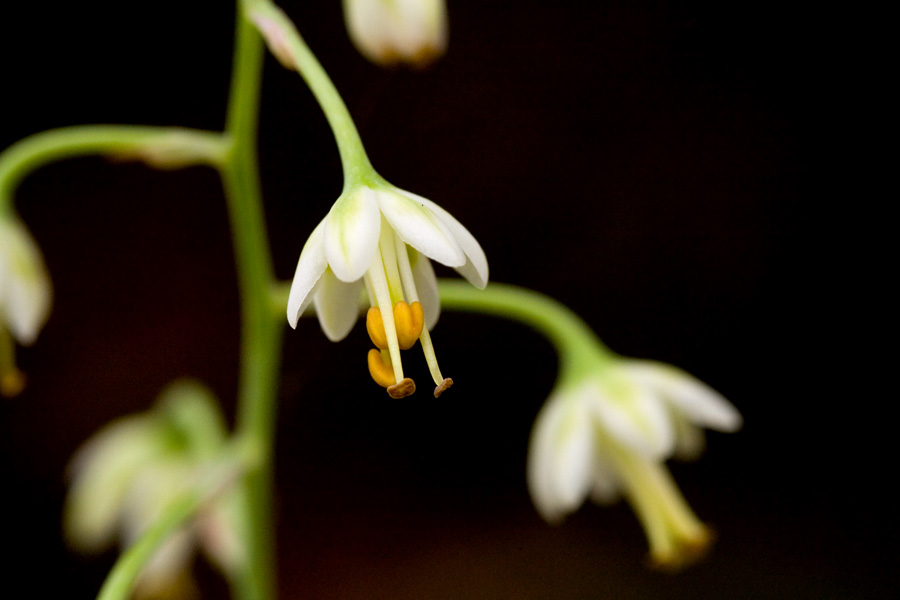Zigadenus
|
Family: Melanthiaceae |
Herbs, perennial, subscapose, bulbous or rhizomatous, all parts containing toxic alkaloids; roots contractile. Leaves usually fewer than 10, mostly basal, alternate, simple, distal ones reduced and grading into floral bracts, sometimes completely sheathing at the base; blade with venation parallel, linear, glabrous, margins entire. Inflorescences terminal, racemose, corymbose, or paniculate, 5-125-flowered, glabrous. Flowers usually bisexual, but often staminate on branches in panicles, protandrous, pedicellate; perianth hypogynous or partly perigynous, white or cream colored to greenish or red tinged, actinomorphic, 0.5-2 cm diam.; tepals 6, often connate basally, each bearing 1 or 2, sometimes obscure to absent, yellow to green, adaxially basal nectary glands; stamens 6, anthers versatile, reniform, dehiscence transverse, extrorse or rarely introrse (Z. glaberrimus); ovary partly inferior; pistil 1, with 3 styles, tapering from ovary; stigmas 3, barely larger than diameter of style, rudimentary in staminate flowers; pedicel ascending to spreading, bracteate, bracts 2, green to red and foliaceous or white and membranous. Fruits capsular, with 3 ellipsoid, beaked sections; dehiscence septicidal, then adaxially loculicidal. Seeds 2-20 per capsule, elongate, twisted and flattened at ends. x = 8, 11, 26. The generic name was spelled Zigadenus by Michaux, but subsequently was often rendered as 'Zygadenus,' presumably to reflect the Greek word roots more clearly. However, the original spelling has priority over that orthographic variant (W. B. Zomlefer 1997b). As broadly circumscribed here, Zigadenus is polyphyletic (W. B. Zomlefer 1997b; W. B. Zomlefer et al. 2001) and this complex has had a complicated taxonomic and nomenclatural history (R. R. Gates 1918; O. S. Walsh 1940; S. J. Preece 1956; F. C. Schwartz 1994; W. B. Zomlefer 1997b). Numerous, variously defined segregates have been recognized, including Anticlea, Chitonia, Cyanotris, Oceanoros, Toxicoscordion, and Tracyanthus. Zigadenus shows morphological similarities to both Stenanthium (including Stenanthella Rydberg) and Amianthium. The common name 'death camas' is derived from the illness or death resulting from ingesting bulbs of Zigadenus that were mistaken for the edible ones of Camassia, an unrelated plant. Many alkaloids found in Veratrum have been isolated from most species of Zigadenus (W. B. Zomlefer 1997b; G. E. Burrows and R. J. Tyrl 2001), including zygadenine and zygacine (T. J. Gilbertson 1973; J. B. Harborne and H. Baxter 1993). All fresh parts of the plant (leaves, bulbs, flowers) are toxic. Dried parts (especially seeds and capsules) are even more potent, presumably because the alkaloids are more concentrated. Ingestion of Zigadenus by humans may result in severe illness and occasionally death even for adults. Livestock (sheep and cattle) poisoning is a serious problem in some rangeland areas of the western United States (C. D. Marsh and A. B. Clawson 1922; V. J. Tepidino 1982). Native Americans used these plants for their analgesic, antirheumatic, and emetic properties, as dermatological and orthopedic aids, and as a snake-bite remedy (D. E. Moerman 1986).
Fls perfect or polygamous; tep 6, all ±alike, with 1 or 2 small flat glands below the middle; stamens 6; filaments slender at least above; anthers extrorse, obcordate, the thecae confluent; ovary 3-lobed, the base sometimes adnate to the base of the perianth, each lobe prolonged into a short divergent style; ovules few; capsule 3-lobed, ovoid to conic, surrounded at base by the persistent perianth; poisonous perennial herbs, the erect stems arising from a bulb or thick rhizome, bearing long linear lvs near the base, reduced or bract-like ones above, and a simple raceme or several racemes or a panicle; fls white or suffused with brown on purple on the lower side. (Anticlea, Oceanoros, Tracyanthus, Zygadenus-a later spelling) 15, N. Amer. and e. Asia. Gleason, Henry A. & Cronquist, Arthur J. 1991. Manual of vascular plants of northeastern United States and adjacent Canada. lxxv + 910 pp. ©The New York Botanical Garden. All rights reserved. Used by permission. |

